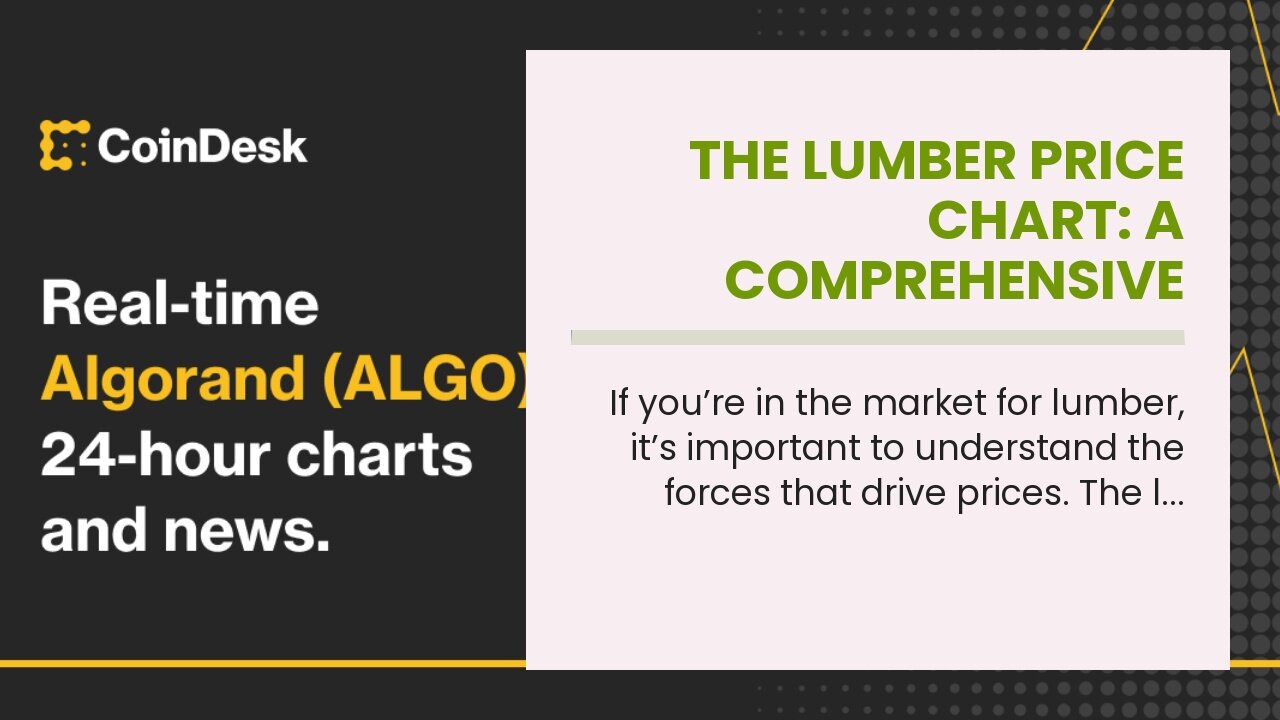Premium Only Content

The Lumber Price Chart: A Comprehensive Guide
The Lumber Price Chart: A Comprehensive Guide
If you’re in the market for lumber, it’s important to understand the forces that drive prices. The lumber price chart is a helpful tool for tracking changes in the market and predicting future trends. In this blog post, we’ll take a comprehensive look at the lumber price chart, including how to read it and what it means for consumers. We’ll also explore the history of the chart and examine some of the key factors that have influenced its development. Finally, we’ll consider some of the trends that are shaping the future of lumber prices. Photo by Erik Mclean on Pexels...
https://finetimer.site/the-lumber-price-chart-a-comprehensive-guide/
If you’re in the market for lumber, it’s important to understand the forces that drive prices. The lumber price chart is a helpful tool for tracking changes in the market and predicting future trends. In this blog post, we’ll take a comprehensive look at the lumber price chart, including how to read it and what it means for consumers. We’ll also explore the history of the chart and examine some of the key factors that have influenced its development. Finally, we’ll consider some of the trends that are shaping the future of lumber prices. Photo by Erik Mclean on Pexels The Lumber Price Chart.
How to read the lumber price chart.
The lumber price chart is a tool that can be used to track and predict changes in the price of lumber. The chart is made up of two parts: the horizontal axis, which shows the date; and the vertical axis, which shows the price per board foot.
To use the chart, simply find the date that you are interested in on the horizontal axis, and then follow that line up to see what the corresponding price per board foot is on the vertical axis. For example, if you are looking at the chart on January 1st, and you want to know what the price of lumber was on December 31st of the previous year, you would find December 31st on the horizontal axis and then follow that line up to see what the corresponding price was on December 31st (in this case, $100).
What does it mean for you?
The information contained in a lumber price chart can be used by both producers and consumers of lumber to make informed decisions about their activities in relation to changes in prices. For example, if you are a contractor who uses lumber in your business, tracking changes in prices can help you budget for upcoming projects and make decisions about when is the best time to buy lumber in bulk. Similarly, if you are a homeowner planning to build a deck or other structure out of wood, monitoring prices can help you choose when is the best time to purchase your materials.
The History of the Lumber Price Chart.
How the lumber price chart has changed over time.
The lumber price chart is not a static document; it changes over time to reflect the changing cost of lumber. The first thing to note is that there are two types of charts: nominal and real. Nominal charts show changes in prices without adjusting for inflation, while real charts do adjust for inflation. This means that when looking at a real chart, one can see how much purchasing power has changed over time.
In general, the price of lumber has been on an upward trend for the past few decades. This is largely due to two factors: population growth and increased demand from China. As more people are born and populations continue to grow, there is greater demand for housing and construction, which drives up the price of lumber. Additionally, China’s economy has been growing rapidly in recent years, and as a result, they have been importing more and more lumber from North America.
What has caused changes in the lumber price chart?
There are a number of factors that can cause changes in the lumber price chart. The most important factor is supply and demand. When there is high demand for lumber (due to population growth or increased construction) but low supply (due to droughts or forest fires), prices will go up. Other important factors include transportation costs (if it becomes more expensive to transport lumber, prices will increase) and government policies (such as tariffs on imported lumber).
The Future of the Lumber Price Chart.
: What trends are affecting the lumber market?
There are a few key trends that are affecting the lumber market and influencing prices. One of the most important is the increasing demand for lumber globally. This is being driven by population growth, particularly in Asia, a...
-
 5:25
5:25
FineTimer
2 years agoThe Merit Circle: How to Get the Most Out of Your Teachers and Learning Opportunities!
632 -
 LIVE
LIVE
Major League Fishing
4 days agoLIVE Tackle Warehouse Invitationals, Stop 5, Day 3
1,405 watching -
 LIVE
LIVE
GritsGG
47 minutes agoWSOW Qualifiers! 👑 2587+ Ws
14 watching -
 1:12:12
1:12:12
Right Side Broadcasting Network
14 hours agoLIVE REPLAY: Defense Secretary Pete Hegseth and Gen. Dan Caine Hold a Pentagon Press Briefing - 6/22/25
132K223 -
 LIVE
LIVE
Sgt Wilky Plays
40 minutes agoMorning Coffee and Karting
24 watching -
 58:09
58:09
Barry Cunningham
4 hours agoLIVE: Defense Secretary Pete Hegseth & Gen. Dan Caine Hold a Pentagon Press Briefing On Iran Bombing
47.5K167 -
 LIVE
LIVE
TonYGaMinG
46 minutes ago🟣 QUESTING TRYIN TO GET READY FOR DEEP DESERT #RumbleGaming
17 watching -
 LIVE
LIVE
TheItalianCEO
3 hours agoPlaying video game is better than touching grass
47 watching -
![[UPDATE 2.4] Hunt: Showdown | Sunday Solo Runs - #RumbleGaming](https://1a-1791.com/video/fww1/16/s8/1/J/A/L/V/JALVy.0kob-small-UPDATE-2.4-Hunt-Showdown-Su.jpg)
LumpyPotatoX2
3 hours ago[UPDATE 2.4] Hunt: Showdown | Sunday Solo Runs - #RumbleGaming
14.8K2 -
 2:12:01
2:12:01
Amish Zaku
3 hours agoVariety Stream
8K2